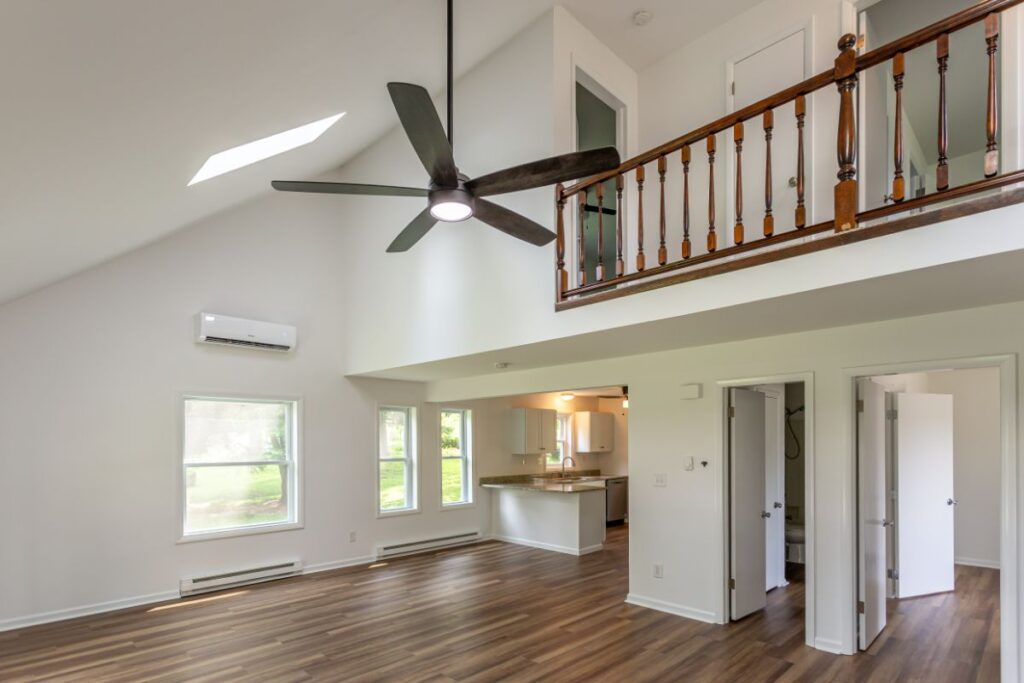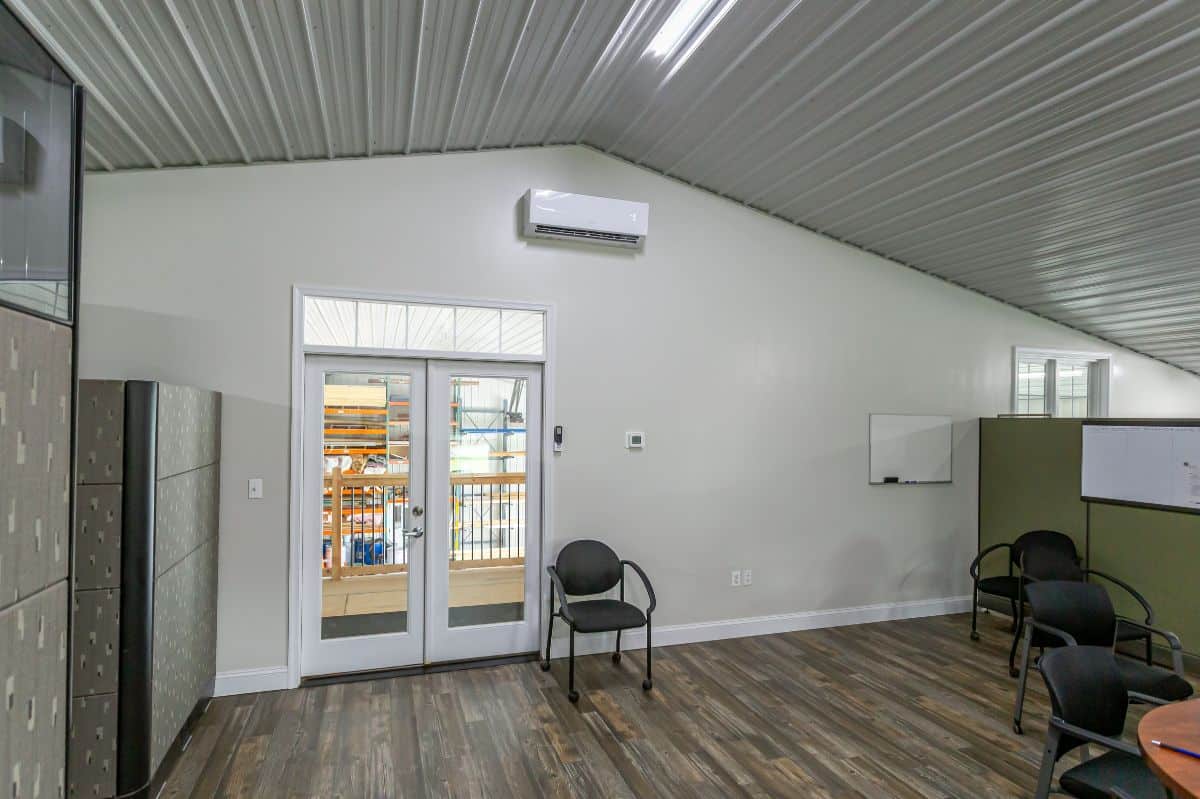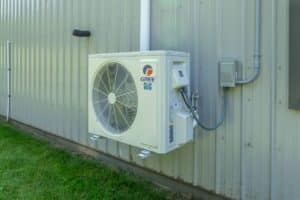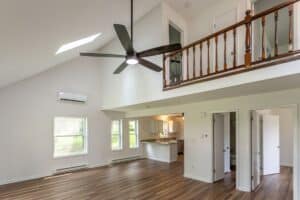Quick Takeaways
- Mini splits are more energy efficient than central systems because they don’t lose heat or cool air through ductwork.
- They offer zoned comfort, ideal for homes without existing ductwork or in need of room-by-room control.
- Central air may still make sense for new construction or when ducts are already in place.
Trying to decide between a mini split system and a central air system for your home? We get this question a lot at Smart Solar. In this guide, we break down the pros, cons, and key differences so you can confidently choose the right cooling system for your needs. We’ll compare mini split vs central air setups in terms of cost, efficiency, aesthetics, and performance across different home types.
Mini Splits vs Central Air: What’s the Real Difference?
Both mini split systems and central air conditioning systems cool your home, but they work in fundamentally different ways. A mini split heat pump uses a two-part setup: one or more compact indoor units mounted in individual rooms and a single outdoor unit located outside the home. These units are connected by refrigerant lines, which allow the system to transfer heat between the inside and outside of your home.
In cooling mode, the mini split absorbs warm air from the room and sends that heat outside, delivering cool air directly into the space through the indoor unit. In heating mode, it reverses the process, pulling warmth from the outside air and delivering it indoors. This direct transfer system eliminates the need for ductwork and makes it easier to control temperatures room by room.
By contrast, a central air conditioning system relies on one large air handler, usually located in a basement or attic, that distributes cool air through a series of ducts to each room. It cools the entire home at once, which is great for even distribution but can be less efficient in homes where you only need to cool specific areas.
Efficiency and Operating Costs
Mini splits are often more energy efficient than central air units. That’s because ductless mini split systems avoid energy loss through ductwork. In many homes, as much as 20 to 30 percent of the energy used to cool air can be lost as that air travels through long ducts—especially if those ducts run through unconditioned spaces like attics or crawl spaces. By skipping the ductwork entirely, mini splits send refrigerant straight to each indoor unit and deliver conditioned air right where it’s needed. This direct delivery reduces strain on the system and lowers your electric bill.
Our mini split systems are also designed to take care of themselves—if there’s a problem like a low refrigerant charge, the unit will try to keep operating until it finally shuts down. While that means you may not notice a decline in performance right away, it also means these systems are better protected from damage and unexpected breakdowns.
Aesthetics and Equipment Visibility
One of the most common objections we hear about ductless mini splits is the look of the indoor unit. Unlike central air, where vents are hidden in ceilings or walls, mini split units are often mounted on walls.
That said, we offer alternate interior options. If you’re building or renovating, we can install ceiling cassettes or other more concealed units. Planning for these during construction allows us to tuck equipment away for a cleaner aesthetic—similar to traditional central air systems.
Heating Compared: Heat Pumps vs Central Air
All of our mini split systems are heat pumps, which means they handle both cooling and heating. While some central air systems can also function as heat pumps, they often include electric backup heat strips. These electric resistance heaters kick on when the outside temperature drops too low for the heat pump to work efficiently. The problem is that electric strip heat is extremely costly to run, especially during extended cold snaps, because it relies entirely on electricity to generate warmth.
In contrast, our mini split heat pumps continue to operate efficiently even in lower temperatures, helping you avoid those high winter electric bills.

Best Fit: When to Choose Each System
Mini Split Systems Are Ideal For:
- Homes without existing ductwork
- Additions, garages, and sunrooms
- Ranch homes and older buildings
- Homes that need zone control and room-by-room comfort
Central Air Systems Work Best For:
- New construction homes with easy attic access
- Townhouses with space for ducts
- Homeowners who prioritize hidden equipment and vents
We’ve found that central air can make more sense in very specific layouts, like two-story townhouses with attic access. But in many older homes—especially ones with limited attic space or obstructions—mini splits offer a more practical and budget-friendly solution, both up-front and in the long-run due to their efficiency.
Addressing Misconceptions With Mini Splits
Some people assume ductless mini splits are less reliable or cost more to repair.
While they do have more components than traditional central air systems, we’ve found they tend to need fewer repairs over time. Plus, our systems are equipped with built-in safeguards and inverter technology that help keep them running efficiently.
Installation Cost and Complexity
In homes that already have existing ducts, a central air conditioner might be easier to install. But for retrofits—especially homes without ductwork—our mini split systems require less invasive work and are often more cost-effective overall.
The initial cost of a mini split may be similar or slightly higher, especially when installing multiple indoor units, but the lower operating costs and flexibility usually make up the difference.
Is a Mini Split Better Than Central Air?
If you want a ductless system with flexible installation options, lower long-term energy use, and precise room-by-room control, then a ductless mini split system is likely the better fit. But for homeowners building new or who already have ducts in place, a central air conditioning system might still make sense.
Whichever route you go, it’s important to weigh your heating and cooling needs, budget, and layout before making a decision. Still unsure? Reach out to us at Smart Solar: we’ll help you compare mini splits vs central air and design the perfect setup for your entire home or particular room.
We do commercial electrician work and off-grid solar installations, too!




